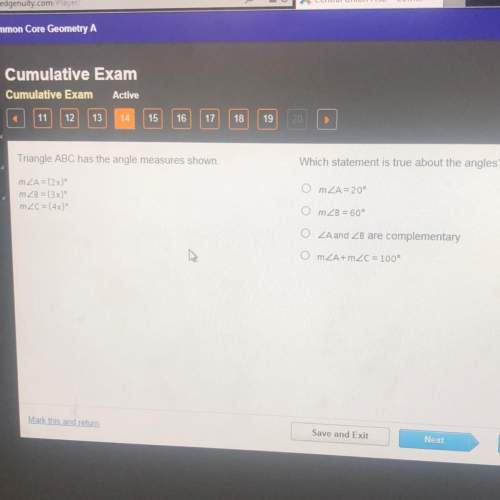
Mathematics, 20.04.2021 20:50 mjwaple57
This pattern follows the rule add 18. What other features do you observe?
14, 32, 50, 68
All terms are even because even + even = even.
All terms are even because odd + odd = even.
All terms are odd because odd + even = odd.
All terms are even because when you add two numbers together, the sums are always
even
PLEASE HELPPP

Answers: 1


Another question on Mathematics

Mathematics, 21.06.2019 12:40
The price of a particular stock is represented by the linear equation , where x represents the number of weeks the stock has been owned and y represents the price of the stock, in dollars. if this relationship continues, what is the price of the stock after it has been owned for 12 weeks? $92.55 $94.37 $100.52 $114.39
Answers: 3

Mathematics, 21.06.2019 22:00
Set $r$ is a set of rectangles such that (1) only the grid points shown here are used as vertices, (2) all sides are vertical or horizontal and (3) no two rectangles in the set are congruent. if $r$ contains the maximum possible number of rectangles given these conditions, what fraction of the rectangles in set $r$ are squares? express your answer as a common fraction.
Answers: 1

Mathematics, 21.06.2019 23:00
Acompany made a profit of 75000 over a period of 6 years on an initial investment of 15000 what is the annual roi
Answers: 1

Mathematics, 22.06.2019 02:30
Atrain traveled for 1.5 hours to the first station, stopped for 30 minutes, then traveled for 4 hours to the final station where it stopped for 1 hour. the total distance traveled is a function of time. which graph most accurately represents this scenario? a graph is shown with the x-axis labeled time (in hours) and the y-axis labeled total distance (in miles). the line begins at the origin and moves upward for 1.5 hours. the line then continues upward at a slow rate until 2 hours. from 2 to 6 hours, the line continues quickly upward. from 6 to 7 hours, it moves downward until it touches the x-axis a graph is shown with the axis labeled time (in hours) and the y axis labeled total distance (in miles). a line is shown beginning at the origin. the line moves upward until 1.5 hours, then is a horizontal line until 2 hours. the line moves quickly upward again until 6 hours, and then is horizontal until 7 hours a graph is shown with the axis labeled time (in hours) and the y-axis labeled total distance (in miles). the line begins at the y-axis where y equals 125. it is horizontal until 1.5 hours, then moves downward until 2 hours where it touches the x-axis. the line moves upward until 6 hours and then moves downward until 7 hours where it touches the x-axis a graph is shown with the axis labeled time (in hours) and the y-axis labeled total distance (in miles). the line begins at y equals 125 and is horizontal for 1.5 hours. the line moves downward until 2 hours, then back up until 5.5 hours. the line is horizontal from 5.5 to 7 hours
Answers: 1
You know the right answer?
This pattern follows the rule add 18. What other features do you observe?
14, 32, 50, 68
All...
All...
Questions


Mathematics, 31.01.2020 13:03


Biology, 31.01.2020 13:03



Mathematics, 31.01.2020 13:03






Mathematics, 31.01.2020 13:03

History, 31.01.2020 13:03

Mathematics, 31.01.2020 13:03


Mathematics, 31.01.2020 13:03

Social Studies, 31.01.2020 13:03






